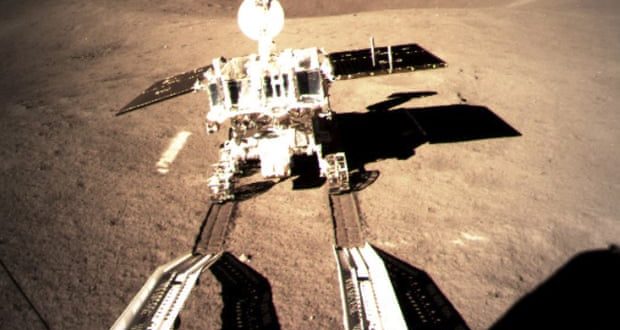Project leader echoes Neil Armstrong’s quote after rover’s successful separation from lander
China’s space agency has posted the first photo of its Chang’e 4 lunar rover on the far side of the moon after its groundbreaking touchdown on Thursday.
The rover – named Yutu 2, or Jade Rabbit 2 – left the spacecraft, drove off a ramp and began making tracks on the moon’s surface at 10.22pm on Thursday, about 12 hours after Chang’e 4 landed.
Lunar project chief designer Wu Weiren called the separation of the rover “a small step for the rover, but one giant leap for the Chinese nation.”
China’s Chang’e 4 mission could use soil tests and temperature measurements to reveal new clues to the cataclysmic collision that created the moon and uncover the origins of the water that is unexpectedly abundant in lunar soil. The Chang’e lunar mission is named after the Chinese moon goddess.
China’s state news agency, Xinhua, said the probe took a small plant called arabidopsis which is expected to produce the first flower on the moon. Other items included in a mini-biosphere include cotton, rapeseed, potato, fruit fly and yeast.
Thursday’s successful touchdown in the unexplored South Pole-Aitken basin, the biggest known impact structure in the solar system, was hailed a major technical feat and is seen as a important step towards China’s wider ambitions in space. Spacecraft have taken pictures of the moon’s far side before, but no lander has ever landed there.
The moon’s far side is sometimes known as the dark side, although it is not darker than the near side in any literal sense. It undergoes the same phases of illumination by the Sun as the side facing Earth. But because the moon spins on its axis at exactly the same rate as it orbits Earth, one side remains permanently out of view.
It was only in 1959, when the first images of the far side were beamed back by the Soviet Union’s Luna 3, that intriguing differences were revealed. The far side is pockmarked by more craters and appears almost devoid of the seas of solidified lava, known as maria, that form the shadowy shape of a face that we see from Earth.
The mission will also conduct the first astronomy observations from the moon’s far side, which is seen as a uniquely attractive site for monitoring radio waves coming from deep space. Astronomers operating Earth-bound radio telescopes have to constantly grapple with electromagnetic interference from human activity: shortwave broadcasting, maritime communication, telephone and television signals. The far side of the moon is shielded from such signals, making it far easier to pick up faint fingerprints left by the Big Bang.
The craft is also carrying a mini-greenhouse, which will test how well plants, specifically potatoes and small flowering Arabidopsis plants, related to cabbage, grow on the moon.
The Guardian
 Lebanese Ministry of Information
Lebanese Ministry of Information



